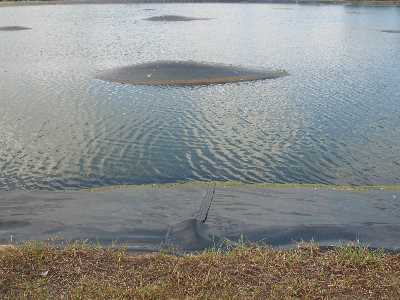
There continue to be (whale) failures of geomembrane liners in waste water treatment plant (WWTP) lagoons and farm manure ponds. These failures are generally due to leakage through the liner, the inability to remove leakage, the generation of methane, and the subsequent inability to vent the methane.
Therefore, when using high-density polyethylene (HDPE) geomembrane liners, carefully consider the following points during the design and installation of these lining systems:
1. Assume that the geomembrane liner will leak a little. It may not, but it probably will.
2. Identify an acceptable leakage flow rate. This is the Action Leakage Rate (ALR) above which the responsible holes must be found and repaired.
3. There are two frequently specified ALRs — 20 gpad for landfills under a 1 ft head, and 500 gpad for municipal WWTP with 6 ft head.
4. Zero leakage is not an option. It might be achieved but it should not be relied upon.
5. Whatever ALR is assumed there should be a leak drainage, collection, and removal system under the geomembrane to handle this leak flow rate.
6. Leaked liquid must be continuously removed to minimize the generation of methane.
7. The floor of the lagoon should be sloped to a sump. It should not be flat.
8. A sloped geocomposite LDS under the liner is desirable for rapid reporting of a leak anywhere in the liner and for allowing gas venting upslope to air vents.
9. A network of geocomposite strips under seams may work but has often been seen not to work.
10. A light geotextile will not function as leak drainage and gas venting system.
11. If concrete embedment strips are used for sealing liner to concrete structures ensure the strip is well-embedded in concrete — no voids underneath, and no gaps or concrete between strip butt joints or beveled corners.
12. Embedment strips and batten strips should be in same plane as liner, not perpendicular with only a short distance between corner and seal.
13. Ensure grinding in preparation for welding is continuous along strip surface.
14. When welding, allow for larger heat sink in strip than in geomembrane.
15. Batten strip seals must have gasket between geomembrane and concrete.
16. Batten strip bolts should not be cranked tight — the objective is to compress the gasket no more than its compressive yield strain.
17. Ensure subgrade is well compacted at edge of concrete, and that concrete corner is rounded.
18. Use geotextile cushion between geomembrane and concrete.
19. Try to avoid underwater seals.
20. Liner should be fully supported when filled. This may need some slack in liner between fixed points if installation is done at higher temperatures. If installation is done at lower temperatures no slack need be built in.
21. Amount of slackness depends on material coefficient of thermal expansion and temperature difference expected
22. The only temperature of interest is the geomembrane temperature.
23. Liner under aerators should be ballasted (concrete slab) to prevent uplift and to provide support for aerator at low water levels.
24. Seriously consider a geoelectric liner integrity/leak location survey when the liner has been completed.
AN ADDITION, COURTESY OF GLENN DARLIEK of LEAK LOCATION SERVICES INC.
25. Don’t plan on puncturing the whales to get rid of them.
Special thanks to Glenn for the contribution! You are right. Mark Smith (formerly of Vector) also added an entertaining note on Geosynthetica’s Facebook page which many of us have heard (and perhaps witnessed the aftermath of): “The most interesting advise I was ever given on whales came from an old timer at a WWTP perhaps 25 years ago. When I asked what he did to get rid of them, he smiled and patted the shotgun hanging in the rack of his pickup truck.”
The primary objectives are to minimize leakage, remove leaked liquids, and vent gases.
Ian Peggs is the president of I-CORP INTERNATIONAL, Inc. He can be reached at icorp@geosynthetic.com.











